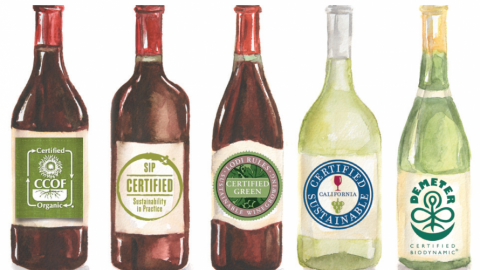How to Be an Eco-Conscious Wine Lover
You’ve decided you want to be more mindful about spending your wine dollars. But it’s not always easy to know which wineries are practicing eco-conscious farming and operations. So we’ve gathered tips and things to look for when you’re deciding which corks to pop.
Do your homework.
Whether you’re planning to buy wine or visit wineries, a little research helps. Many wineries have a “sustainability” tab or page on their website. If a winery has a specific certification, you’ll see that prominently displayed. We’ve also published a handy guide to eco-wine certifications.
Check online directories from sustainable farming organizations.
You can search for eco-conscious vineyards and wineries throughout California.
Check regional winery association websites.
Often these organizations will highlight sustainably-minded wineries. For example, the Wines of Santa Clara Valley lists member wineries that are certified sustainable or are working towards full sustainability.
Ask questions when visiting wineries or at wine tasting events.
Start a conversation with the tasting room folks and ask how the vineyards are farmed, if they plant cover crops or have animals grazing between the vines. What about bottle weights and shipping containers? Often the winemakers can tell you more. Bill Cooper at Cooper-Garrod Estate Vineyards is often on-hand to give guests a little more detail on his sustainability and viticultural methods. Some wineries offer informative vineyard walks or tours too.
Look for physical signs of sustainability.
Do you see signs in the vineyards, such as raptor boxes, beehives, cover crops or other plant diversity besides just grapevines?
Read the labels.
You may see wording such as “Made with organically grown grapes,” or seals from CSWA (California Sustainable Winegrowers Association) or CCOF (California Certified Organic Farmers) on front or back labels. Cooper-Garrod Estate Vineyards takes it one step further by listing the wine’s ingredients. Clos LaChance’s red wines are vegan and their wine labels sport a green V with a leaf to mark their commitment.
Buy local wine.
Buying local is the best way to get a sense of place in your glass, both in tasting the terroir and supporting their efforts to translate sustainable winemaking into great wine. Supporting local wineries connects you to their eco-conscious ethos and sustainable business practices. By shopping local, your wine dollars can also help wineries support the community through charitable donations and fundraisers.
Drink local wines at local restaurants—and if you don’t find many or any on the wine list, speak up.
Even though many restaurants source local, seasonal produce and ingredients, their wines may come from all over. Ask about local and regional wines, ask about sustainably grown local wines, ask about pairings of local ingredients and wines. There is a difference, and you can make an impact by sharing your interest in local, regional and California "green" wine with local restaurants.
“I would love it if people paid attention and would gently and good-naturedly put some pressure on local restaurants to carry local wines,” says Tom Fogarty Jr. of Thomas Fogarty Winery. “It’s only going to change one way, and that is with consumers.”
We couldn’t have said it better. Drink local. To Your Health, Earth!




